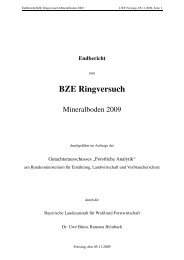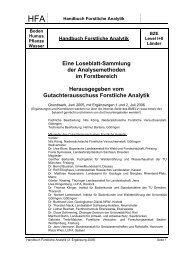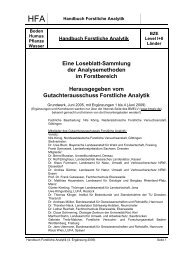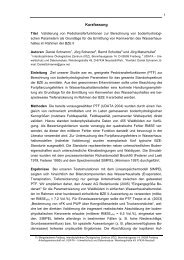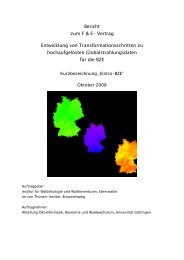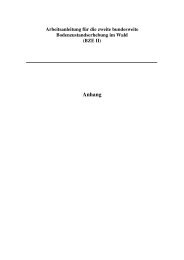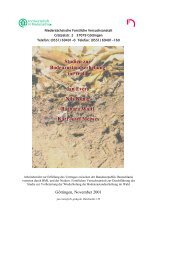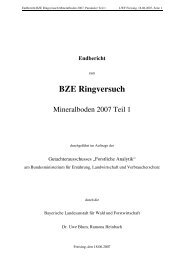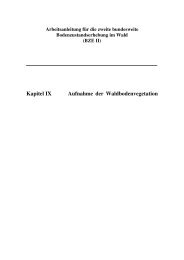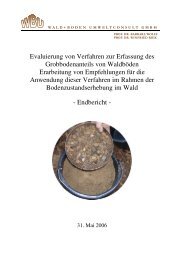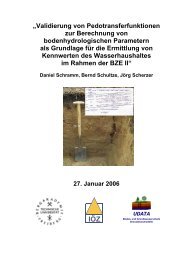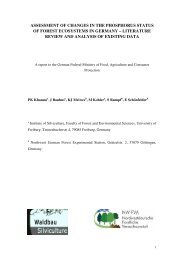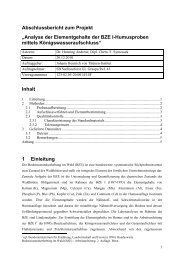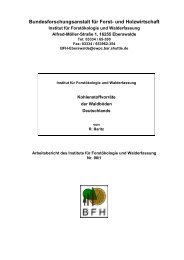assessment of changes in the phosphorus status of forest ...
assessment of changes in the phosphorus status of forest ...
assessment of changes in the phosphorus status of forest ...
You also want an ePaper? Increase the reach of your titles
YUMPU automatically turns print PDFs into web optimized ePapers that Google loves.
assess P <strong>status</strong> or any <strong>changes</strong> <strong>in</strong> P <strong>status</strong> <strong>of</strong> soils by us<strong>in</strong>g simple methods, ra<strong>the</strong>r <strong>the</strong><br />
complex nature <strong>of</strong> <strong>in</strong>teractions requires special techniques <strong>of</strong>ten <strong>in</strong>volv<strong>in</strong>g a number<br />
<strong>of</strong> different methods. It was shown that P <strong>in</strong> <strong>the</strong> soil solution phase determ<strong>in</strong>es P<br />
uptake but it is <strong>the</strong> most dynamic component <strong>of</strong> soil P. Through solubility product<br />
diagrams it has been possible to assign <strong>the</strong> dom<strong>in</strong>ant <strong>in</strong>organic forms <strong>of</strong> P which may<br />
be determ<strong>in</strong><strong>in</strong>g <strong>the</strong> concentrations <strong>of</strong> P <strong>in</strong> soil solutions. A conceptual framework is<br />
normally used to assign differences <strong>in</strong> <strong>the</strong> lability <strong>of</strong> different soil P fractions with<br />
respect to <strong>the</strong>ir availability for uptake. Sequential extraction methods are used to<br />
obta<strong>in</strong> P fractions which are differently labile. However, not <strong>the</strong> easily labile fractions<br />
undergo <strong>changes</strong> <strong>in</strong> <strong>the</strong> long term but <strong>in</strong> many cases <strong>the</strong> fractions <strong>of</strong> moderate to low<br />
turnover <strong>in</strong>dicat<strong>in</strong>g <strong>the</strong> dynamic equilibria occurr<strong>in</strong>g among different forms <strong>of</strong> P. This<br />
creates a problem for select<strong>in</strong>g <strong>the</strong> suitable chemical fractions which could be<br />
extracted by appropriate methods. Consequently <strong>the</strong>re are many different types <strong>of</strong> soil<br />
P tests which are used both <strong>in</strong> agriculture and <strong>forest</strong>ry. Agricultural methods have<br />
been developed specifically to provide fertilizer recommendations for crops, and are<br />
thus <strong>of</strong> limited use to describe <strong>the</strong> long-term P <strong>status</strong> <strong>of</strong> <strong>forest</strong> soils. The limitations<br />
and advantages <strong>of</strong> various methods have been described.<br />
We recommend a method <strong>in</strong>clud<strong>in</strong>g repeated extractions <strong>of</strong> soil P by us<strong>in</strong>g an<br />
appropriate extractant. The selection <strong>of</strong> extractant(s) would require some <strong>in</strong>itial<br />
studies. Such a repeated desorption <strong>of</strong> P from soils will provide a capacity factor<br />
giv<strong>in</strong>g <strong>the</strong> amount <strong>of</strong> labile fraction and a desorption rate function which may be<br />
related to soil characteristics. Any change <strong>in</strong> those two parameters would <strong>the</strong>n<br />
<strong>in</strong>dicate a change <strong>in</strong> P <strong>status</strong> <strong>of</strong> soil. The development <strong>of</strong> <strong>the</strong> method should be done<br />
on a small but representative set <strong>of</strong> soils <strong>of</strong> <strong>the</strong> BZE collective. In order to save<br />
resources, for <strong>the</strong> rest <strong>of</strong> <strong>the</strong> samples <strong>the</strong>se parameters may be obta<strong>in</strong>ed by develop<strong>in</strong>g<br />
suitable models us<strong>in</strong>g NIRS or MIRS techniques. The proposed method will still<br />
require a high level <strong>of</strong> resource commitment to be made available <strong>in</strong> future under <strong>the</strong><br />
BZE program. Despite <strong>the</strong> major concerns <strong>of</strong> <strong>changes</strong> <strong>in</strong> P <strong>status</strong> <strong>of</strong> <strong>forest</strong> soils, this<br />
area <strong>of</strong> research has not received sufficient attention <strong>in</strong> <strong>the</strong> past.<br />
4. ACKNOWLEDGEMENTS<br />
A number <strong>of</strong> persons provided ideas, data evaluation and support for this document.<br />
We wish to thank for <strong>the</strong>ir efforts: Dr. Carl Hoecke, Dr. Jan Evers, Dr. Henn<strong>in</strong>g<br />
Meesenburg and Dr. Michael M<strong>in</strong>drup.<br />
73



